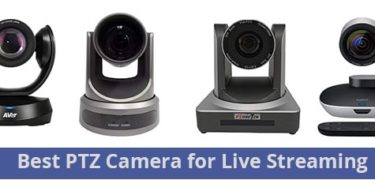As an Amazon Associate, I can earn from qualifying purchases. Learn more.
Do you want to remotely view your security cameras from anywhere in the world? If yes, you have to make sure you have enough internet speeds on the location of your CCTV system. This internet speed we now speak is the bandwidth and it describes the amount of data that can be transferred across a given path in a given time.
In general, we have two paths that a security camera or any other device connected to the internet follow: Upload and download. Just as the name, upload speed explains the bandwidth used to send data to the internet. Then, download speed is the bandwidth of bringing data down from the internet.
But if everything goes back to upload and download, how much bandwidth do I need for security cameras to stream seamlessly?
Understanding Upload and Download Internet Speed
If you have a WiFi wireless security camera, the internet is the key to streaming live feed footage. The internet connection is like the “Ethernet cable” or “BNC cable” to connect your camera to the viewing device (laptop or smartphone).
So, the upload speed is the internet bandwidth your security camera can use to send information to your phone or laptop. And download speeds refer to the amount of internet bandwidth you use to receive or else stream the information from the camera on your phone/ laptop.
But again, the amount of data your camera needs to send information is more than that your phone needs to retrieve it. Think of it like a hill and you. You’ll require more energy to reach the peak than when climbing down.
Therefore, the network of your camera location has to be very strong if the amount of data crossing is heavy. This explains why most WiFi cams record by event or even why we have fewer standalone 4K security camera systems.
How To Measure Bandwidth Of A Security Camera
Similar to any other unit of measurement, bandwidth has its convention. It’s a form of a unit of speed around a unit of data (computing and digital information). Hence, the reason it’s measured in bits (e.g. 100kb/s, 1Mb/s, 1000Mb/s, et cetera), which we also tend to use in storage.
However, sometimes the bandwidth requirements of a CCTV can be higher than the standard measurement. A good example is when using a higher resolution security camera system with DVR or NVR since the consumption will be accounted for all connected cameras.
In such a case, the system will need a higher unit of measurement, which happens to be bytes. 8 bits of data makes 1 bit. So, it’s more like with distance, whereby you can measure in inches if it’s small or goes with the yard when larger.
Even so, bits and bytes can be confusing if you’re not careful. Not just by the way they sound too alike but also by the shorthand reference letter. Bits use “b” but lowercase, whereas bytes use “B” in uppercase. If it’s 100KB/s vs 100Kb/s, you have to remember “Bytes” is bigger (8 times) than “bits”.
But again, video footage needs thousands and thousands of bits to stream. Hence, the reason you will always come across terms like kilobits (1000 bits), Megabits (1,000,000 bits), or Gigabits (1,000,000,000 bits) and Kilobytes (1000 bytes), Megabytes (1,000,000 bytes), or Gigabytes (1,000,000,000 bytes).
How Much Bandwidth Do I Need For Security Cameras?
Technically, there’s no set standard of bandwidth consumption by security cameras. Various models have different rates, which mostly depend on the amount of data transmitted.
But then, the amount of data that a particular camera sends over the internet depend on specific capabilities set. They include:
Resolution: the higher it’s, the more bandwidth it will use
Audio: cameras recording video with audio will pack a bit heavier data than those sending pictures only. So, the bandwidth consumption will also be high.
Frame rate: As we mentioned the other day on a 4K 30fps security camera, a high frame rate camera captures more images in each second than lower counterparts. So, the bandwidth consumption will also be high.
Video codecs: advanced video compression, i.e. H.265 or H.265+, works around reducing the original file of footage without affecting the visual quality. Hence, requires less bandwidth than the standard H.264 codec.
Scene complexity: If a camera is in high traffic, the image sensor will have more data to process, including the moving cars and people, audio, and smart algorithms like facial recognition (if available). So, it will use more bandwidth than a camera recording a blank wall.
Mainstream vs Sub stream Video Recording
As we said earlier, the amount of bandwidth of a security camera is measured individually. Even with an expandable 8 channel security camera system, the consumption rate will be for each plugged-in camera, not the one recorder. So, you’ll need to sum up the bandwidth of all the cameras on a network to get the total load. If you have like ten cameras, this could result in high bandwidth demand and could affect your other devices connected to the same network.
Nonetheless, if your CCTV system does support both mainstream and sub-stream recording, you can lower this consumption rate significantly. Sub-stream is like a secondary video streaming method whereby it reduces the bandwidth consumption by lowering image details.
If it’s like a 2MP 30fps camera that has a mainstream (normal Full HD) bandwidth of 5Mb/s, the sub-stream can use around 512Kb/s – 1Mb/s. Hence, can be a big saver where you have many cameras in a slow network or your viewing device has poor cellphone reception.
How To Calculate Bandwidth Requirements Of Your Security Camera
To determine the total bandwidth load of all your cameras connected to a network:
Total bandwidth (Mbps) = Bitrate (mainstream) * N +Bitrate (sub-stream) * M, where N & M are the number of cameras connected.
Ps. Bitrate (bit rate) is a measure of how much data a camera uses when it’s recording or streaming over the internet in a given amount of time. It mostly relies on the resolution and frame rate, albeit other factors like video compression affect it too.
To know the bitrate of either the mainstream or sub-stream of a security camera you’re buying, you can check in the specifications chart from the provider. If not listed and the manufacturer hasn’t responded to your email, use the bandwidth calculator or the following chart to do a rough estimation. Then, at least you can know the internet you have at home is enough or not.
| Resolution | Frame Rate | Bandwidth(in standard H.264) | Bandwidth (in HEVC H.265) |
|---|---|---|---|
| 720p HD | 30fps | 2.0Mb/s | 1.5Mbps |
| 1080p Full HD | 15fps | 2.3Mbps | 1.7Mbps |
| 1080p Full HD | 30fps | 4.5Mbps | 3.4Mbps |
| 4MP Super HD | 15fps | 4.3Mbps | 3.2Mbps |
| 4MP Super HD | 30fps | 8.6Mbps | 6.4Mbps |
| 4K Ultra-HD | 15fps | 9Mbps | 6.7Mbps |
| 4K Ultra-HD | 30fps | 18.1Mbps | 13.4Mbps |
Final Thoughts:
If you have a WiFi wireless camera or wired CCTV, internet is a must-have to remotely access the footage. But as we have seen, you really must determine the total bandwidth load of the devices to see if your home connection is enough.
When your camera is experiencing low bandwidth, let’s say from slow modem upload, you’ll have to deal with “jumpy” videos. This could lead to you missing some crucial moments or in worst cases have nothing to see after the camera loses signal completely.
Nonetheless, if the CCTV system has both mainstream and sub stream, you could adjust the latter. Hence, maximizing the available bandwidth and at the same time enjoy better remote viewing. But then, do note the streaming video quality will be lesser than when using the normal mainstream codec.



